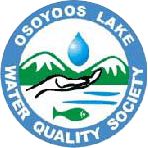Water Levels
What causes fluctuations in the level of the lake?
Osoyoos Lake averages 911 feet above sea level. There are natural seasonal fluctuations in lake levels depending on runoff from the mountain snowpacks and general precipitation. The highest level usually occurs in May and June. The current maximum permissible level determined by international agreement is 913 feet above sea level during a drought year. The lowest levels average 910.5 feet and usually occur between January and March.
The level is also controlled by Zosel Dam, situated at the U.S. end of Osoyoos Lake in Oroville, WA. The amount of water allowed out of the lake by Zosel Dam is decided each spring by the International Joint Commission (IJC) Osoyoos Lake Board of Control. Its decision is based on examination of snowpack activity, precipitation, current water levels, and weather forecasting estimates for that year.
Osoyoos Lake flows into the Okanogan* River in Washington State which supplies water to agriculture and residents in that immediate area. Also, the Similkameen River (which runs parallel to the Okanagan River) joins the Okanogan River about 5 km south of Oroville. During periods of excessive precipitation/runoff the water in this river may ‘back up’ into the Okanogan River, causing flooding.
So, during periods of drought (as declared by the Board of Control) more water is allowed to flow from Osoyoos Lake into the Okanogan River. If the opposite happens, they may partially close the dam to allow less water to flow south.
There are concerns that the Zosel Dam is acting as a ‘plug’ for pollutants and toxins coming down the Okanagan River from communities to the north of Osoyoos: ie they are forced to back up into Osoyoos Lake instead of being allowed to flow freely downstream and dissipate naturally in wetlands.
*NB: Difference in spelling of Okanagan. In Canada it is spelled Okanagan, in the U.S. the spelling changes to Okanogan.






